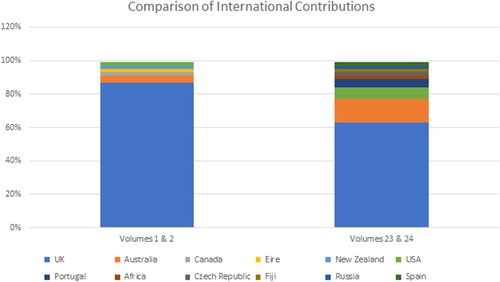ABSTRACT
This article reviews key themes in articles published in Perspectives over the past 25 years since the journal was launched. It highlights changes in the journal itself and its readership as the higher education landscape has evolved. We review the first few editions in the journal and key topics over the past quarter century. This article concludes by looking at the future of the higher education sector and the role of university administrators as important actors in this influential industry.
Introduction
Much has changed in the dynamic higher education environment over the last 25 years. A historical analysis of articles published in Perspectives since 1997 reflects the changes in scale and scope of higher education and key challenges for university administrators. Inevitably, there have also been changes in the journal itself and the audience that it serves. The full title Perspectives: Policy and Practice in Higher Education not only distinguishes the journal from others with ‘Perspectives’ in their title but also highlights the nature of the content – a concern with both policy and practice. In the very first edition, Celia Whitchurch (Citation1997) suggests that
As well as being a ‘serious’ journal, publishing full length refereed papers of up to 4000 words, perspectives aims to offer an exchange of views, experiences and ideas, and to be a source of information on, for instance, those books, articles and reports which you always meant to read but never quite got round to.
To celebrate 25 years of Perspectives, this anniversary article analyses 46 articles in the first two volumes of Perspectives, published in 1997 and 1998, and 44 articles of volumes 23 and 24, published in 2019 and 2020 respectively, (at the time of writing only the first two issues of volume 25 have been finalised). An examination of these 90 articles reveals changes in the nature of contributions in Perspectives, the changing nature of contributors, growth in international submissions, the emergence of special issues, and continuity in themes about the nature of higher education. Book reviews have been excluded from the analysis: there were seven in the first two years and only four in the later two-year period.
The nature of contributions
For the first two years of publications in Perspectives, the majority of articles were based on professional experience rather than on research – less than a tenth of articles were based on research studies. However, there were also reflections on official reports – three of these on the Dearing Report and one on the, earlier, Harris Report (Citation1996) on postgraduate education. Some of these earlier articles sought to improve understanding of administrative functions that might not be widely and fully understood, for example, Estates, Finance and IT departments. Articles relating to personal, or staff, development continue to form an important segment of articles with a tenth of articles in these early years emphasising staff development, rising to nearly double that figure in the more recent issues. Unsurprisingly, change itself has been a topic for many articles – none expressly so in the first two volumes but with over a tenth of articles in the latter two volumes relating explicitly to change management. Among those articles were some that also reflect a trend more recently in the journal of introducing literature reviews that were missing from earlier issues of the journal. Articles concerning the professional identity of managers, administrators and ‘third space professionals’ have continued to occupy the minds of contributors. The first two volumes included two articles on professional identities. By volumes 23 and 24, this had doubled to four.
The nature of contributors
The range of contributors has expanded and changed shape as the proportion of contributors from senior positions in universities has decreased. In the issues of Perspectives published in the first two years, about a quarter of the contributions were written by very senior administrators, e.g. vice-chancellors, deans, registrars, or their equivalents. About a quarter were written by senior managers such as librarians, directors of estates, finance, and those working in staff development while only four percent were submitted by academic members of staff.
In contrast, only five percent of articles published in the most recent issues of Perspectives were submitted by very senior managers and academic staff contributed nearly half of the articles. Professional services staff accounted for just over 40 percent of articles in Perspectives and another five percent came from consultants. In volumes 23 and 24, one article was written by a student. However, there is some overlap in these categories, with a number of articles co-authored by teams including academics and administrators or academics and students. Moreover, several contributors were undertaking further part-time study while working in professional services.
Internationalisation
One of the most striking changes over the last 25 years of Perspectives is the increasing spread of international authorship of articles. and show a comparison and analysis of percentages of articles emanating from different countries. In one or two cases, the origins of the principal authors are shown and in one case the origins are listed as ‘Africa’ when one main author was located in South Africa and the other in Mozambique.
Table 1. Analysis of country of origin of published articles.
The change from nearly nine out of 10 articles being submitted by author(s) from the UK, to less than two-thirds, is striking, as is the increase of Australian contributions from one in 25 to one in seven. The range of countries covered has also increased from five from outside the UK in the early two-year period to seven from outside the UK more recently. In the early period, all of the articles came from English-speaking countries, however, in the later period one in eight articles originated from a country where English is not the first language. Data from our publishers, Taylor & Francis (Citation2021) shows that in the period covered by volumes 23 and 24, 56 percent of article downloads were from Europe, with a third of those being from the UK. North America featured in 18 percent of article downloads and Asia and Australasia were each mentioned in 11 percent of downloads. Africa received three percent of downloads and Central and South America just one percent. Comparative data are not available from 25 years ago as access at that time was only through paper copies but based on the wider geographic origins of recent authors, it seems safe to assume that the journal now has a much wider readership than in the early years.
Special issues
The last few years have seen a number of special issues published that highlighted important developments within higher education. The latest one earlier this year focused on equity and access, concerns about widening participation, attainment gaps and admissions challenges. Other special issues have covered such areas as managing human resources, access to higher education, the challenge of quality, and the internationalisation of higher education. One of the first special issues focused on digital IT and the future usage of IT in higher education. The article by Michael Coen and David Nichols (Citation2007) on investing in digital technologies for e-learning demonstrates how far the sector has come, particularly given the speed with which the sector responded to moving to full on-line learning from March 2020. It is useful to look back to see the progress that has been made. Special issues enable authors and readers to understand some of the main challenges within specific – and at times niche ̶ areas of the sector. They are useful when looking to resolve some of the intractable challenges faced by all institutions both within the UK and overseas.
The nature of higher education
What has not changed during this 25-year period is the notion that higher education is constantly in flux. Government regulations, tuition fee increases, the UK Office for Fair Access (now the Office for Students) and the reinvention of professional services staff to support these changes are all indicators of this constant change. Several of the articles in Volume 23 and 24 discuss the identity of professional services staff. Katie Akerman (Citation2020) has recently discussed the identity of third space professionals with higher education institutions. Lindsay Melling (Citation2018) has written about identity and nomenclature and the importance of being recognised as a professional within higher education. Additionally, Natalia Veles, Margaret-Anne Carter, and Helen Boon (Citation2019) have examined how the third space professional fits in the global higher education sector. As changes to higher education continue and the identities and skills of professional services staff evolve, it is vital that Perspectives provides valuable space to those staff for dialogue and reflections going forward.
The future of higher education
No one can predict what the future will hold for higher education but with value for money and student success and outcomes high on the agenda for The Office for Students in the UK, it is fair to assume that Whitehall and the devolved administrations will require more changes and reporting mechanisms. It is imperative that higher education professionals are sufficiently able and agile to respond to and lead in an ever-changing environment. The AUA has recently undertaken a study on the future of higher education professionals (AUA Citation2020). One of the research findings from 90 percent of the professional services staff respondents in this study was that they felt their role was going to change in the next five years. They highlighted the need for them to be supported in redefining their roles as the number of non-traditional roles increases. As third space and other types of higher education professionals increase, it is timely to re-examine how professional services staff are defined and categorised to demonstrate the breadth and width of the roles undertaken across the sector.
The future of Perspectives
As higher education and the nature of this journal’s readership evolve, we are seeing a much more diverse range of topics being reviewed for each edition. For example, recent articles have included a piece on leadership programmes for LGBT+ staff members by Catherine Lee (Citation2021) and on gender differentials in science subjects by Dawn Bennett, Sherry Bawa, and Subramaniam Ananthram (Citation2021). Reflections on stakeholder engagement with local communities and surrounding societies have been covered by Kristina Julin Nyquist and Ulla Ahonen-Jonnarth (Citation2021). Such contributions demonstrate useful insights and foresight in a context of the UN’s Sustainable Development Goals. It is also heartening to see the breadth of topics downloaded and cited which indicates readers’ wide-ranging interests. It is vital that Perspectives continues to represent and publish work by both academic and professional services staff which articulates important and topical issues taking place in higher education both in the UK and internationally.
Conclusions
Higher education has transformed considerably over the past 25 years. This has been reflected in the pages of Perspectives. Some of the journal’s most notable successes have been increases in both international authors and international readership as well as in the proportion of academic contributions. The journal editors and reviewers have consistently aimed to provide a voice for higher education managers and administrators and to showcase thoughtful leadership as the sector has grown and professionalised. There is much to learn from the past to help us understand the turbulent present and plan for future opportunities and challenges as well look forward to the next 25 years. As the French say, plus ça change, plus c'est la même chose.
Acknowledgements
We are grateful to Julie Davies, Book Review Co-Editor and Jean Grier, Associate Editor, for their comments on an earlier draft.
Disclosure statement
No potential conflict of interest was reported by the author(s).
Additional information
Notes on contributors

Bland Tomkinson
Bland Tomkinson is Editor of Perspectives and is a Visiting Academic at the University of Manchester, where he has held a variety of roles over the last forty-two years.

Joanne Caldwell
Joanne Caldwell is the Co-Deputy Editor for Perspectives and is the Centre for Doctoral Training Manager at the University of Salford. She is currently writing up her EdD focusing on the identity of professional services staff.

Charlotte Verney
Charlotte Verney is the Co-Deputy Editor for Perspectives and is Registry Strategic Projects Lead at Canterbury Christ Church University. She is currently writing up her EdD focusing on the changing nature of higher education administrative work.
References
- Akerman, K. 2020. “Invisible Imposter: Identity in Institutions.” Perspectives: Policy and Practice in Higher Education 24 (4): 126–130.
- AUA. 2020. Future HE Professionals. Accessed June 19, 2021. https://aua.ac.uk/future-he-professionals/.
- Bennett, D., S. Bawa, and S. Ananthram. 2021. “Gendered Differences in Perceived Employability among Higher Education Students in STEM and Non-STEM Disciplines.” Perspectives: Policy and Practice in Higher Education 25 (3): 84–90.
- Coen, Michael, and David Nicol. 2007. “Managing Investment in Teaching and Learning Technologies.” Perspectives: Policy and Practice in Higher Education 11 (1): 25–28.
- Harris, M. 1996. Review of Postgraduate Education. London: HEFCE.
- Lee, Catherine. 2021. “Promoting Diversity in University Leadership: The Argument for LGBTQ+ Specific Leadership Programmes in Higher Education.” Perspectives: Policy and Practice in Higher Education 25 (3): 91–99.
- Melling, L. 2018. “What’s in a Name? Job Title and Working Identity in Professional Services Staff in Higher Education.” Perspectives: Policy and Practice in Higher Education 23 (2–3): 48–53.
- National Committee of Inquiry into Higher Education (Dearing Report). 1997. Higher Education in the Learning Society. London: HMSO.
- Nyquist, Kristina, and Ulla Ahonen-Jonnarth. 2021. “Strategic, Fundamental and Means Objectives of Different Stakeholders in Collaboration Between Universities and Surrounding Society.” Perspectives: Policy and Practice in Higher Education. Advance online publication. doi:10.1080/13603108.2021.1946866
- Taylor and Francis Group. 2021. Perspectives: Policy and Practice in Higher Education – Confidential Publishing Report. Unpublished.
- Veles, N., M.-A. Carter, and H. Boon. 2019. “Complex Collaboration Champions: University Third Space Professionals Working Together Across Borders.” Perspectives: Policy and Practice in Higher Education 23 (2–3): 75–85.
- Whitchurch, C. 1997. “A New Publishing Initiative in Higher Education.” Perspectives: Policy and Practice in Higher Education 1 (1): 1.

